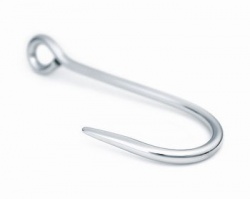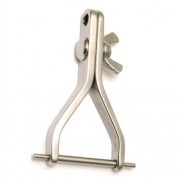Flesh hook
Some people go to enormous effort to manufacture hooks for use with suspension and related flesh hook rituals such as pulling. However, the manufacturing of fish hooks is big business, and high quality hooks are easy to obtain from fishing supply houses (and they're a lot cheaper than suspension-specific hooks). The caveat of course is that they have barbs on them, but these can be easily ground off.
Contents |
Types
There are two basic types of hooks, the standard open design (shown above) and locking (commonly referred to as a "Gilson" hook). Locking hooks are fairly new, and there are several designs out there. The primary purpose for the locking mechanism is to increase the amount of weight a hook can hold (the lock keeps the hook from opening) and to prevent the hooks from coming out (for example, if suspending from great heights).
Standard hooks (fishing hooks) are definitely the most commonly used design for suspension. They are cheap, easy to find, and quite durable. These hooks normally come in two forms: open and closed eye (the top opening where the rope is connected). Closed eye hooks are probably the most common because the rope it less likely to come detached, although open eye are useful in situations where rigging quickly is a concern.
Philip Barbosa of the suspension group iWasCured adds:
- "You may want to mention this as well because I made the mistake the first time of buying the wrong hooks and they rusted badly in the autoclave. The two kinds of hooks usually used in suspension are salmon hooks and octopus hooks. Salmon because they are inexpensive and come in gauges from 10 up to 8, and octopus hooks because they come in gauges from 8 to 4. Both are the only type of hooks available from Mustad at least that are large gauge open or closed eyed and more importantly, made of stainless steel. Almost all other hooks are made of a very high carbon steel and coated in tin or some other metal -- these are not suitable."
It is important that stainless steel hooks are used—most fishhooks are made of a high carbon coated steel which will quickly rust when autoclaved. Mustad salmon hooks (available in 10ga through 8ga) as well as Mustad octopus hooks (available in 8ga through 4ga) are some of the more commonly used (and easy to find) hooks.
Sizing
Hook sizing is the reverse of jewelry gauge -- the larger the number, the bigger the hook. Salmon hooks (for example, the hooks made by "Mustad") in the following sizes are most commonly used in body ritual:
9/0 -- about the same as 8ga jewelry
8/0 -- somewhere between 8ga and 10ga jewelry
7/0 -- about the same as 10ga jewelry
Certain activities call for different gauges:
- 18ga to 14: Used primarily for ball dancing or similar activity. These are too small for suspension unless a very large number of hooks are used.
- 12ga to 10ga: Sometimes used for horizontal suspension, but usually too small for vertical suspensions.
- 9ga: Common size for horizontal suspension, sometimes used for vertical suspensions as well.
- 8ga: This is the most common size for most suspensions and can be used for almost anything.
- 6ga and larger: Normally used for two- or one-point suspensions, or in vertical suspensions for larger individuals.
Load
Static loading on these hooks maxes out at about 80 pounds per hook, with dynamic loading being in the 40-50 pound range per hooks. Larger hooks such as Sea Demons are also available (which can handle 150 pounds or more, per hook, without tearing or straightening). If the suspendee swings during a suspension the force on the hook can change dramatically (the dynamic load generated will be much more than the static weight of the person and the rig). Hooks are always a crucial variable that must be tested.
Vertical suspensions are usually done with four to six hooks (with extra hooks for the arms in the case of a crucifix suspension), and horizontal suspensions are generally done with eight to twelve hooks, but are not uncommonly done with as many as 24 hooks.
The amount of hooks used per suspension depends on two factors, the experience level of suspendee experience and weight of the suspendee. A good rule of thumb is as follows:
- 15-20 pounds per hook for beginners (ie. 8 hooks for a 140 pound guy)
- 20-40 pounds per hook for intermediate (ie. 4 hooks for a 140 pound guy)
- 40-80 pounds per hook for advanced (ie. 2 hooks for a 140 pound guy)
- Only experienced individuals should attempt 80+ pounds per hook.
As for determining the amount of hooks for each style of suspension, this depends a lot on physical geometry. The vertical suspension really only has one central weight apex, so the least amount of hooks can be used for these. The horizontal suspensions however have four basic areas of weight: chest, hips, legs and arms. Facing upward (in a coma suspension) each point must be held by hooks or by the some other means (such as strapping). Facing downward, (in a superman suspension) the chest and hips are combined into one variable due to the fact that the hips do not bend forward.
Finishing
Finishing is as simple as cutting off the barb, grinding it smooth, and polishing. Power tools will, of course, make this process go dramatically faster, but there is no reason this couldn't be done entirely with hand tools.
Placement
As for skin, different areas of the body handle weight differently. For example the back can hold over 250 pounds from one point, where knees seem to rip at around 100 pounds. Depth of the piercing can also play a dramatic role in tearing. The hook needs to be placed where the body's weight is evenly distributed over the hook. If the hook is placed too deep, the skin will bunch up causing the entire pressure to be placed on the entrance and exit points. Conversely, if the piercing is too shallow, the force is focused on one point.
Hooks can be sharpened to a point and forced through the skin, although this is unnecessarily painful and traumatic. The most common and practical means of insertion is to first make the hole with a standard piercing needle and follow that through with the hook.
Needle and hook are usually in the same size, but that is entirely optional. If a larger needle is used (for example, a 6ga piercing needle followed by an 8ga hook), there will be additional bleeding. If a smaller needle is used, the hooks may be tighter and be a bit sorer prior to suspension.
It is essential to maintain a proper set up to avoid risks of contamination of the fresh piercings and of the equipment—this should be a top priority. Many suspension crews choose to set up an assembly line where one person pierces and inserts the hooks, and another preps the rigging system so that it's more difficult to contaminate the framework.
Never pierce through muscle! Skin is very resilient, holds a lot of weight and heals very quickly. Muscle, on the other hand, is a very fragile tissue that tears easily and does not always heal correctly. In addition, if hooks tear out, damage to skin is easy to heal and not particularly dangerous, whereas healing torn muscle is much more significant.
Leaving in the Hooks
This would depend first on the material of the hooks. Most stainless fishhooks are certainly not implant grade stainless, and therefore should be removed after suspending. There are some custom made hooks on the market made from implant grade materials and that are specifically designed for suspension. These hooks could, at least from a materials point of view, be left in for very extended times.
Once the hooks are put in and the person is prepped for suspension, they have roughly an hour to chill with the hooks in. However, the longer they wait, the less endorphins will be flowing, and, additionally, drying fluids around the piercings will make them more painful—it is best to suspend as soon as possible after the piercings are done.
Once down after a suspension, it is best to remove the hooks and burp out the air as soon as possible.
Where to Get Them
Any fishing supply shop can order these hooks for you, and you can also order them from a variety of online suppliers (many people use Seattle Marine). Other companies such as Good Art, Industrial Strength Needles, Steal Body Jewelry and micromutazioni (www.micromutazioni.com) also make suspension hooks, including "locking" hooks which have a "latch" on them, so even if they bend, they shouldn't actually come open.

